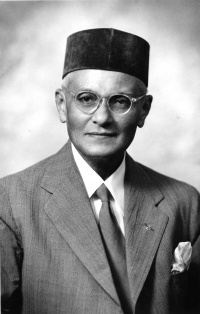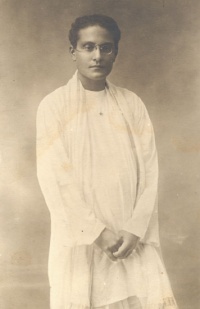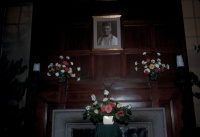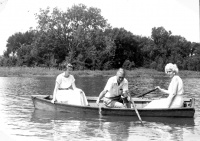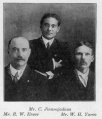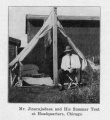Curuppumullage Jinarājadāsa: Difference between revisions
| Line 14: | Line 14: | ||
== Early years and education == | == Early years and education == | ||
Mr. Jinarājadāsa was born on [[December 16]], 1875 in Ceylon (now Sri Lanka) of Sinhalese Buddhist parents in a town about fifteen miles (24 km) south of the capital city, Colombo. The name Curuppumullage indicates a person "Curuppu" living in the house or town of Mullage. The surname Jinarājadāsa can be interpreted in various ways, but is a combination of three words: jina (winner), raja (king), and dāsa (servant) | Mr. Jinarājadāsa was born on [[December 16]], 1875 in Ceylon (now Sri Lanka) of Sinhalese Buddhist parents in a town about fifteen miles (24 km) south of the capital city, Colombo. The name Curuppumullage indicates a person "Curuppu" living in the house or town of Mullage. The surname Jinarājadāsa can be interpreted in various ways, but is a combination of three words: jina (winner), raja (king), and dāsa (servant). | ||
His association with [[Theosophy]] began at the age of thirteen when, as one of the first students of [[Ananda College]], he met [[Charles Webster Leadbeater|C. W. Leadbeater]]. The following year, [[Alfred Percy Sinnett|A. P. Sinnett]] asked Mr. Leadbeater to return from India to England to tutor his son [[Percy Edensor Sinnett|Denny]] and [[George S. Arundale|George Arundale]], Leadbeater brought Raja with him. The three boys were close in age: Raja was born in 1875, Denny in 1877, and George in 1878. | His association with [[Theosophy]] began at the age of thirteen when, as one of the first students of [[Ananda College]], he met [[Charles Webster Leadbeater|C. W. Leadbeater]]. The following year, [[Alfred Percy Sinnett|A. P. Sinnett]] asked Mr. Leadbeater to return from India to England to tutor his son [[Percy Edensor Sinnett|Denny]] and [[George S. Arundale|George Arundale]], Leadbeater brought Raja with him. The three boys were close in age: Raja was born in 1875, Denny in 1877, and George in 1878. | ||
Revision as of 20:50, 5 December 2013

NOTE: THIS ARTICLE IS UNDER CONSTRUCTION
NOTE: THIS ARTICLE IS UNDER CONSTRUCTION
Curuppumullage Jinarājadāsa (1875–1953), was a Sri Lankan scholar, lecturer, and writer who served as the fourth President of the Theosophical Society based in Adyar, Chennai, India from 1945 to 1953. An accomplished linguist, he traveled extensively for fifty years an an international lecturer, speaking in English, French, Italian, Spanish, and Portuguese. He was known to his wide circle of friends as "Raja", "Brother Raja", or "CJ".
Early years and education
Mr. Jinarājadāsa was born on December 16, 1875 in Ceylon (now Sri Lanka) of Sinhalese Buddhist parents in a town about fifteen miles (24 km) south of the capital city, Colombo. The name Curuppumullage indicates a person "Curuppu" living in the house or town of Mullage. The surname Jinarājadāsa can be interpreted in various ways, but is a combination of three words: jina (winner), raja (king), and dāsa (servant).
His association with Theosophy began at the age of thirteen when, as one of the first students of Ananda College, he met C. W. Leadbeater. The following year, A. P. Sinnett asked Mr. Leadbeater to return from India to England to tutor his son Denny and George Arundale, Leadbeater brought Raja with him. The three boys were close in age: Raja was born in 1875, Denny in 1877, and George in 1878.
In 1889, Jinarājadāsa met Madame Blavatsky for the first time. He became a member of The Theosophical Society on March 14, 1893 through the London Lodge. He entered St John’s College, Cambridge in 1896, and four years later took his Degree in the Oriental Languages Tripos, and also studied Law. He then went back to Ceylon where he became Vice-Principal (1900-1901) of Ananda College in Colombo, founded by Henry Steel Olcott. In 1902 he returned to Europe to study literature and science at the University of Pavia, Italy. In 1904 he went to America, where he began his career as an international lecturer of the Theosophical Society,
Marriage
In 1916, Mr. Jinarājadāsa married Miss Dorothy M. Graham, an English member who founded the Women’s Indian Association with Margaret Cousins.
Theosophical work
During the administration of Annie Besant, Brother Raja served as Vice President of the Society, from 1921 to 1928.
Mr Jinarâjadâsa was editor of The Theosophist for three periods of time. Annie Besant turned over that responsibility when she was interned for three months in 1917, and again in 1931-33 during her last illness. He resumed the editorship during his term in office as President of the Society from 1946–53.
Travels as international lecturer
Presidency
Mr. Jinarâjadâsa served as President of the Society from 1946 until 1953, when he resigned due to illness.
According to his official biography:
As President, during the post-war years, Brother Râjâ, as he was affectionately called, was very concerned about Adyar as it was affected by a shortage of workers, military occupation of the ocean frontage and consequent public traffic through the estate. He did his best to free Adyar of all its entanglements and restore it to its earlier serenity, as the centre of Theosophical thought and the symbol of the unity of the Society, and preserving its international character.
In 1949 Jinarâjadâsa founded the School of the Wisdom at Adyar, for the study of Theosophical teachings in depth as given in the textbooks, but primarily because a student knowing these things could with widened vision ‘sit in the centre’ of his own being and ‘enjoy clear day’ in his understanding of the world of men and affairs. The School was also to devote its studies to the thoughts of the great and the affairs of men in the larger sense through historical time. Its yearly sessions attract students from several countries to this day. He tried to make the Headquarters once more a centre for students and gradually reorganized the estate for that purpose. Jinarâjadâsa could always present his thoughts with clear and delicate appreciation of the pictures his words would create in the minds of his readers.[1]
Final years
Writings
C. Jinarājadāsa was a very prolific writer, and a list of his works is in a separate article, Jinarājadāsa writings.
Articles are indexed in the Union Index of Theosophical Periodicals. Over 1600 articles are listed under the name Jinarājadāsa.
Searching under CJ will result in a list that includes work by Charles Johnston, a Sanskrit scholar who was married to Madame Blavatsky's niece, and who was also known by those initials. Within the results list, the articles by Mr. Jinarājadāsa will include those in the periodicals: The Adyar Bulletin, The American Theosophist, The Australian ES Bulletin, The Herald of the Star, The Messenger, Sishya (The Student), The Theosophic Messenger, The Theosophist, and World Theosophy. Articles by Charles Johnston appear in Theosophical Quarterly, Theosophy, The Path, and The Irish Theosophist.
Photo gallery
Online resources
Articles
- "C. Jinarajadasa" by Surendra Narayan. This article was originally published in Quest 93.6 (November-December 2005): 228-229.
Social media
- Curuppumullage Jinarajadasa on Facebook.
Notes
- ↑ "C. Jinarājadāsa (1875–1953)", TS Adyar Web Page. Available at TS Adyar Web page.
